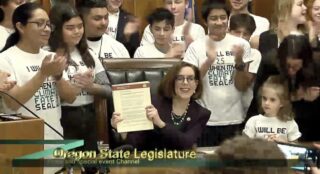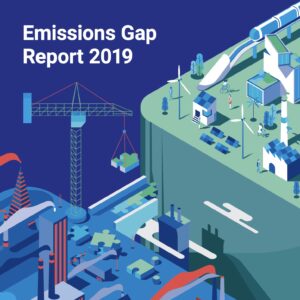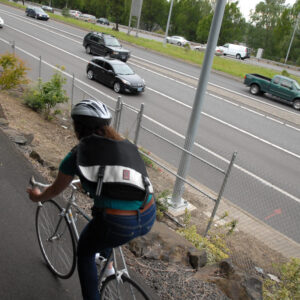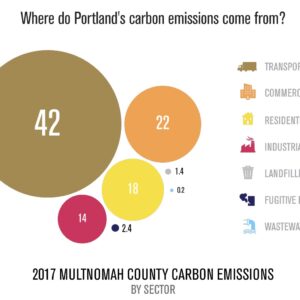
(Photo from Oregon Legislative Information System livestream.)
Fed up with repeated walk-outs by Republican lawmakers over their objections to climate change legislation, today Oregon Governor Kate Brown took the matter into her own hands. Brown signed Executive Order 20-04 (PDF below) at her desk in Salem this morning surrounded by young students from around the state.
At the signing, Brown said, “I think this Executive Order is extremely bold and aggressive.” The order itself justifies the action by stating, “Given the urgency and severity of the risks from climate change and ocean acidification and the failure of the Legislature to address these immediate harms, the executive branch has a responsibility to the electorate, and a scientific, economic, and moral imperative to reduce GHG emissions and to reduce the worst risks of climate change and ocean acidification for future generations, to the greatest extent possible with an existing laws.”
The order specifically calls out 19 state agencies and governor-appointed commissions. Among them are the Oregon Department of Transportation (ODOT) and the Oregon Transportation Commission (OTC).
The transportation sector is responsible for about 40% of Oregon’s GHG emissions, the largest of any single source. Today’s action by Governor Brown says ODOT and the OTC have a legal requirement to reduce those emissions. The order says ODOT and other state agencies “Shall exercise any and all authority and discretion vested in them by law” to reduce emissions enough to meet the state goal of at least 45% below 1990 emissions levels by 2035 and at least 80% below 1990 emissions Levels by 2050.
Advertisement
The order also calls on ODOT to “prioritize and expedite” actions that could accelerate GHG emission reductions and to prioritize climate change impacts in their planning, budget, and investment decisions. ODOT is among 10 agencies that must report their progress on GHG emission reductions to the Governor by May 15th, 2020 and they must be part of a new workgroup on climate impacts.
Even more specific to ODOT and the OTC, Brown’s order says they must prioritize implementation fo the Statewide Transportation Strategy adopted in September 2019. That strategy calls for less ambitious emission reductions than this new executive order and as we reported in 2018, a report by the Oregon Global Warming Commission found that ODOT’s own monitoring shows they are nowhere near reaching even those lower targets. Last time we checked ODOT was on course to achieve only a 15-20% reduction in GHG emission by 2050.
Furthermore, the order directs ODOT to set metrics and then evaluate GHG impacts of all transportation projects in regional transportation plans. “ODOT is directed to identify and implement means to provide financial and technical assistance to metropolitan planning areas for amendment to transportation and land-use plans that meet the state GHG reduction goals or more stringent goals adopted by a metropolitan planning area,” the order reads.
Advertisement
ODOT will also have to make emissions reduction efforts the responsibility of staff “at the highest level” of the agency. That person/staff will have to make “regular and direct” reports to the Governor.
Will this speed up ODOT’s work on congestion pricing? Will it make it more like the OTC will demand a full Environmental Impact Statement for ODOT’s I-5 Rose Quarter project? Or will ODOT find ways to check the boxes and continue business as usual. I’ve asked ODOT for their reaction to the order but have yet to hear back.
Climate change and transportation activist Catie Gould read the order and said, “Seeing how it didn’t mention public transit or moving away from cars at all, I don’t see how it will change anything ODOT is doing. They’ll pin their plans on going electric, and keep pushing their congestion = emissions bad science.”
Another element to the order is Governor Brown’s directive for ODOT to “conduct a statewide transportation electrification infrastructure needs analysis.” It’s not yet clear if that analysis will include charging locations for electric bicycles in addition to cars and trucks.
Asked at today’s press conference if she’s worried about a legal challenge to the order, she said there will be plenty of time for the public to weigh in on the proposals during an upcoming, several month rulemaking process and any legal challenge would come after that. “I encourage Oregonians to use their voices during that process,” Brown said. “These young people have been waiting for years. They’ve been promised action on climate change.”
You can read the executive order below or download the PDF here.
[pdf-embedder url=”https://bikeportland.org/wp-content/uploads/2020/03/EO-20-04-with-Governors-signature.pdf” title=”EO 20-04 with Governor's signature”]
Check out more coverage of the executive order from OPB and The Oregonian.
— Jonathan Maus: (503) 706-8804, @jonathan_maus on Twitter and jonathan@bikeportland.org
— Get our headlines delivered to your inbox.
— Support this independent community media outlet with a one-time contribution or monthly subscription.







Thanks for reading.
BikePortland has served this community with independent community journalism since 2005. We rely on subscriptions from readers like you to survive. Your financial support is vital in keeping this valuable resource alive and well.
Please subscribe today to strengthen and expand our work.
Does “reduce emissions” mean “reduce idling by adding more lanes” to ODOT?
Good question. I can’t fathom how this squares with her appointing the former head of the CRC project as ODOT’s new director, nor this new director’s subsequent action of forming a “mega-projects” division tasked exclusively with pushing these projects through.
It’s mostly political. Small teeth. It seems like there is enough there that a citizen or something with standing could use it to kill ODOT projects but it wont really change the course of ODOTs plans.
It’s mostly “Thous shalt reduce emissions” rather than “You will reduce emissions in x way and if you don’t y will happen”.
Just more posturing from neo-liberal lawmakers
And it works nearly every time.
60% of the time, all the time…
It’s also based enforcement of current laws rather than creating new ones, and we already know Oregon’s record on enforcement…
I recall hearing ODOT state something about the I5 project reducing greenhouse gas emissions because it reduces congestion…
“…and keep pushing their congestion = emissions bad science.”
Unfortunately that isn’t just bad science, it is mendacious.
Equating congestion reduction with mitigating climate change is like suggesting plantation owners outsource the whipping as a way to mitigate slavery.
Nice false equivalency 🙂
Yep. That’s true. I hope that now with the new regulations in the Exec. Order they’ll have to do more math and offer more proof beyond their usual propaganda and lies. It also adds a layer of accountability to Governor Brown where it should be easier for activists to blame her for ODOT’s bad performance. We’ll see.
By the time any meaningful numbers are in, she will be making $500,000 a year as a lobbyist,
Give me your money and your rights. Is it ever anything different?
“I know what’s best for you, and it’s gonna cost ya”.
Make cycling only days mandatory!
Just another New Year’s resolution…..
Typo? “greatest extent possible with an existing laws.” Shouldn’t it be “greatest extent possible within existing laws.”? with an versus within?
Yes, an EO is not as powerful as a bi-partisan legislative law passed and signed by the governor. BUT what I hope the Governor does is use it as a big stick with her administrative appointees to their division managers…true trickle down. Hopefully administrative policies will be updated and communities (in urban and suburban areas at a minimum, and rural too) will then push their legislative representatives to fund them (and unfund old bad projects that are still on the shelf).
OTOT runs OTC and GOV.
“We can’t save the world by playing by the rules, because the rules have to be changed. Everything needs to change – and it has to start today.”
–Greta Thunberg
I don’t understand the order or the failed bill. The governor could quickly reduce greenhouse gases AND save billions of dollars by simply appointing a new heads of ODOT and the OTC that would eliminate wasteful and polluting freeway projects. Starving the freeway beast would save the planet and our wallets. Efficient public and active transportation is fiscally conservative and conserves the environment. If gas taxes can only go toward projects to increase gas consumption, get rid of them. For those who think private electric cars on endless asphalt will save everything, I suggest this article. The toxic wasteland from high tech batteries mined and processed in China with coal power can be seen from space. https://www.bbc.com/future/article/20150402-the-worst-place-on-earth
Catie Gould said it well. This EO is a pretty mewing noise that will do next to nothing.
One thing that always gets my goat is when people like our governor claim that e-cars are zero emission vehicles. They most certainly are not. They have enormous embodied GHG emissions that work out to about 2 tons of CO2/yr of use. They also have tire and brake particulate emissions during operation that kill somewhere between 40-150k Americans every year. Add in the fact that we have not yet created a zero-emission grid, and that adding transportation demands in the form of multi-ton e-cars to it will slow or reverse progress in reducing electrical generation emissions. E-cars are but a tiny step forward relative to ICE cars and the time for tiny steps has passed.
Greta Thunberg once said something to the effect that people in power are willing to make only those changes that don’t inconvenience them. This EO is a perfect example of that.
My first question to ODOT, in light of this, would be: “will you finally staff up your rail division”?
[ODOT has like 3 full time rail employees AFAIK.]